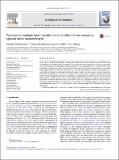Payment for multiple forest benefits alters the effect of tree disease on optimal forest rotation length
Abstract
Forests deliver multiple benefits both to their owners and to wider society. However, a wave of forest pests and pathogens is threatening this worldwide. In this paper we examine the effect of disease on the optimal rotation length of a single-aged, single rotation forest when a payment for non-timber benefits, which is offered to private forest owners to partly internalise the social values of forest management, is included. Using a generalisable bioeconomic framework we show how this payment counteracts the negative economic effect of disease by increasing the optimal rotation length, and under some restrictive conditions, even makes it optimal to never harvest the forest. The analysis shows a range of complex interactions between factors including the rate of spread of infection and the impact of disease on the value of harvested timber and non-timber benefits. A key result is that the effect of disease on the optimal rotation length is dependent on whether the disease affects the timber benefit only compared to when it affects both timber and non-timber benefits. Our framework can be extended to incorporate multiple ecosystem services delivered by forests and details of how disease can affect their production, thus facilitating a wide range of applications.
Citation
Macpherson , M F , Kleczkowski , A , Healey , J R & Hanley , N 2017 , ' Payment for multiple forest benefits alters the effect of tree disease on optimal forest rotation length ' , Ecological Economics , vol. 134 , pp. 82-94 . https://doi.org/10.1016/j.ecolecon.2017.01.008
Publication
Ecological Economics
Status
Peer reviewed
ISSN
0921-8009Type
Journal article
Description
This work is from the project titled Modelling Economic Impact and Strategies to Increase Resilience Against Tree Disease Outbreaks, which is funded jointly by a grant from BBSRC, Defra, ESRC, the Forestry Commission, NERC and the Scottish Government, under the Tree Health and Plant Biosecurity Initiative.Collections
Items in the St Andrews Research Repository are protected by copyright, with all rights reserved, unless otherwise indicated.

